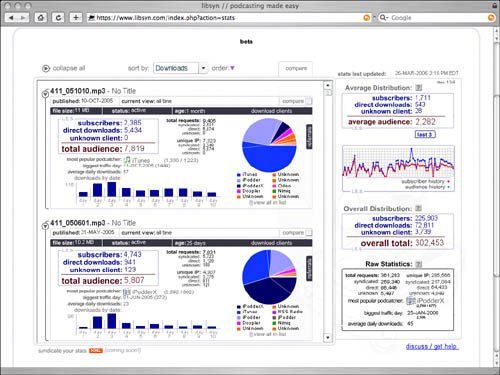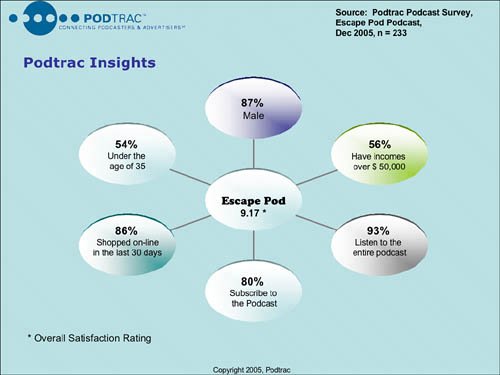Tracking Stats and Getting Listener Info
When it comes to your stats, the number-one question that needs to be answered is, How many people are listening to your show? Although the question is pretty straight forward, the results are often a bit fuzzy. What you are really looking for is the number of unique downloads of your show. By "unique" we mean the number of unique listeners who have complete downloads of the show. This is different from a show's "total downloads," which is always higher because some listeners download multiple copies and many don't complete the full download. Additionally, many people just getting into podcasting make the mistake of counting the number of times their XML file is hit each day and think this is the number of subscribers. Nothing could be further from the truth, because your listeners' podcatchers are likely to hit your feed once an hour. Plus, you will also have the different podcasting directories pinging your feed. So you can pretty much ignore the number of hits to your RSS feed as it appears in your raw log stats unless you have a tool to parse those logs. Tip One tool that analyzes your raw logs is Podalyzer at http://hexten.net/podalyzer. This is not a tool for the "flashing 12's" or even those of moderate techie skills. This is a tool only for the über geeks. It is a Perl script that analyzes raw server logs and produces reports on MP3 downloads. FeedburnerLuckily for those of us less geeky there is Feedburner, a service that over 45,000 different podcasters have used. Traditionally, the service was used to track the number of subscribers to a blogs RSS feed. Thus, with the arrival of podcasting, Feedburner became a very widely accepted service when looking at tracking the number of subscribers to a show. Feedburner is useful because it looks at the number of unique requests for your RSS feed in a 24-hour period. It is not just counting the raw number of hits to the RSS feed. Up until early 2006, Feedburner only looked at the number of subscribers to a show, so this meant if you had 20% to 30% of your downloads as direct downloads, they would go unreported. That changed in early 2006. Rick Klau with Feedburner had this to say about its new offerings:
When asked if Feedburner would be offering a way for podcasters to generate revenue, Rick had this to say:
Rick did state that by the time this book was published the specifics on how Feedburner could help podcasters generate revenue would be much better defined. Therefore, be sure to go to www.feedburner.com to see the latest offerings for podcasters and how it compares with those mentioned later in this chapter. LibsynLiberated Syndication (Libsyn) is the biggest player on the hosting side of podcasting, with well over 3,000 podcasters using this service. One of the reasons for the popularity of Libsyn is the stats package it offers (see Figure 18.1). One thing Libsyn does is to break out the downloads by those subscribed to your show and those that do a direct download. Rob spent over 10 months tracking the results from Libsyn and comparing them to those from Feedburner, and he found that the number of downloads from subscribers after 7 days was very close to the peak subscriber number given by Feedburner during that 7-day period. And by close he means less than a 5% difference, and typically less than a 2% difference. Rob has also talked to other podcasters who use both Feedburner and Libsyn and found that many other podcasters had similar results. Figure 18.1. Libsyn stats showing the number of subscribers via RSS and direct downloads for a single show, the overall downloads for all shows combined, and the average audience size for the last three shows. Both Libsyn and Feeburner look at unique downloads and have separate algorithms to calculate that number. Because the numbers are very close, it is unlikely that both services are in error the same amount and in the same direction. What this means is that you should feel comfortable reporting stats from either service to a potential advertiser. Note Some in the podcasting community have reported issues with either Libsyn stats or Feedburner stats. However, based on our own observations and those that other podcasters allowed us to review, we feel confident that the stats from both services are reliable. We do realize that no stats are 100% accurate, and we do not mean to imply these services are. They are just much more accurate than simply looking at the raw log files. Determining Your DemographicsOnce you get an idea on the size of your audience, you need to figure out who that audience is. You can choose from a few different ways and services to try and figure this out. Audible.com offers the service Wordcast Pro, which provides some very nice information.
In addition to Audible, both Kiptronic and Podtrac have surveys that you can add to your site to have your listeners fill out. You probably have seen one or both of these surveys' buttons on the sites of some of your favorite podcasts. With Kiptronic, you get access to a single-page summary of information after just 10 surveys have been completed. For Podtrac, the data is available after 50 surveys have been completed, but it also includes a full eight-page summary. That said, listeners can also fill out the Kiptronic survey more quickly, making them more likely to do so. Figure 18.2 shows the summary slide from the Podtrac survey for Escape Pod. Figure 18.2. Summary slide from a Podtrac survey for Escape Pod. Remember, if you are having a hard time getting listeners to vote for you, you will likely have a hard time getting them to fill out a survey. You could always make up your own survey. If you have your show notes on your forum, you could put a new poll question up with the release of each show. Start simple: male or female? Then ask for age range, income range, educational background, and so on. If you do not place your show notes on your forum, you can simply link to the forum and have a different question with the release of each show. Or you could email out surveys to those listeners who have sent you emails, asking them to fill out the survey. You might offer up a prize, such as an iPod Nano or a $25 iTunes gift card, to one random person from all those who fill out the survey. This is a lot more work on your part, but it may result in more feedback if you are not getting results from simply asking people to fill out your survey. Tip If you're looking for a good way to find out where your listeners live, you may want to make use of the Frappr map tool (www.frappr.com). Many podcasters use this as a way to build a community around their podcast, but it also provides valuable information about where your listeners are located. |
EAN: 2147483647
Pages: 162
